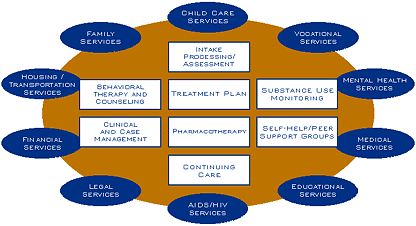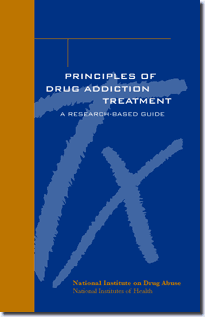
|
Frequently Asked Questions
| Treatment varies depending on the type of drug and the characteristics of the patient. The best programs provide a combination of therapies and other services. |
1. What is drug addiction treatment?
There are many addictive drugs, and treatments for specific drugs can differ. Treatment also varies depending on the characteristics of the patient.
Problems associated with an individual's drug addiction can vary significantly. People who are addicted to drugs come from all walks of life. Many suffer from mental health, occupational, health, or social problems that make their addictive disorders much more difficult to treat. Even if there are few associated problems, the severity of addiction itself ranges widely among people.
A variety of scientifically based approaches to drug addiction treatment exists. Drug addiction treatment can include behavioral therapy (such as counseling, cognitive therapy, or psychotherapy), medications, or their combination. Behavioral therapies offer people strategies for coping with their drug cravings, teach them ways to avoid drugs and prevent relapse, and help them deal with relapse if it occurs. When a person's drug-related behavior places him or her at higher risk for AIDS or other infectious diseases, behavioral therapies can help to reduce the risk of disease transmission. Case management and referral to other medical, psychological, and social services are crucial components of treatment for many patients. (See Treatment Section for more detail on types of treatment and treatment components.) The best programs provide a combination of therapies and other services to meet the needs of the individual patient, which are shaped by such issues as age, race, culture, sexual orientation, gender, pregnancy, parenting, housing, and employment, as well as physical and sexual abuse.
|
Drug addiction treatment can include behavioral therapy, medications, or their combination.
|
Treatment medications, such as methadone, LAAM, and naltrexone, are available for individuals addicted to opiates. Nicotine preparations (patches, gum, nasal spray) and bupropion are available for individuals addicted to nicotine.
Components of Comprehensive Drug Abuse Treatment

[Click to Enlarge]
The best treatment programs provide a combination of therapies and other services to meet the needs of the individual patient.
Medications, such as antidepressants, mood stabilizers, or neuroleptics, may be critical for treatment success when patients have co-occurring mental disorders, such as depression, anxiety disorder, bipolar disorder, or psychosis.
Treatment can occur in a variety of settings, in many different forms, and for different lengths of time. Because drug addiction is typically a chronic disorder characterized by occasional relapses, a short-term, one-time treatment often is not sufficient. For many, treatment is a long-term process that involves multiple interventions and attempts at abstinence.
2. Why can't drug addicts quit on their own?
Nearly all addicted individuals believe in the beginning that they can stop using drugs on their own, and most try to stop without treatment. However, most of these attempts result in failure to achieve long-term abstinence. Research has shown that long-term drug use results in significant changes in brain function that persist long after the individual stops using drugs. These drug-induced changes in brain function may have many behavioral consequences, including the compulsion to use drugs despite adverse consequencesÑthe defining characteristic of addiction.
|
Long-term drug use results in significant changes in brain function that persist long after the individual stops using drugs.
|
Understanding that addiction has such an important biological component may help explain an individual's difficulty in achieving and maintaining abstinence without treatment. Psychological stress from work or family problems, social cues (such as meeting individuals from one's drug-using past), or the environment (such as encountering streets, objects, or even smells associated with drug use) can interact with biological factors to hinder attainment of sustained abstinence and make relapse more likely. Research studies indicate that even the most severely addicted individuals can participate actively in treatment and that active participation is essential to good outcomes.
[Guide Index][Previous Section][Next Section - FAQs (cont.)]
|

|

All materials in this volume are in the public domain and may be used or reproduced without permission from the Institute or the authors. Citation of the source is appreciated. The U.S. government does not endorse or favor any specific commercial product or company. Trade, proprietary, or company names appearing in this publication are used only because they are considered essential in the context of the studies described here.NIH Publication No. 00-4180Printed October 1999, Reprinted July 2000
|
|